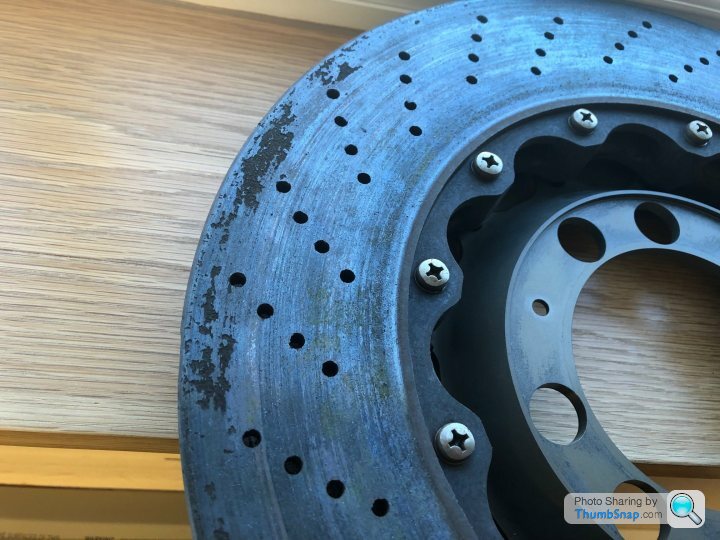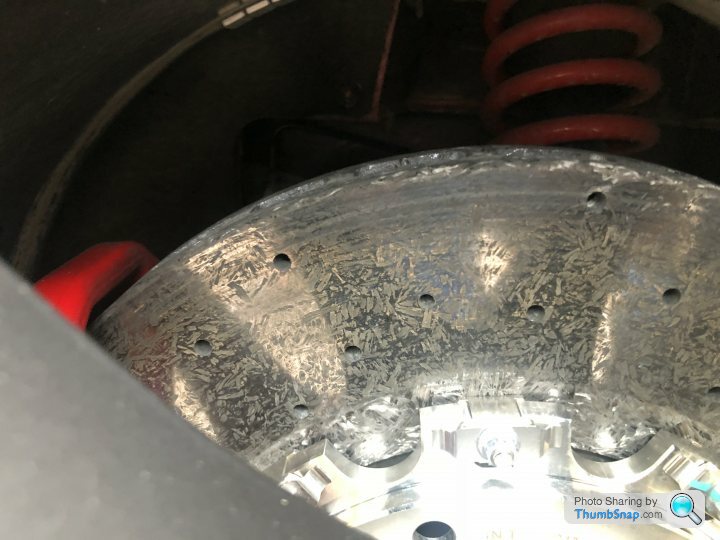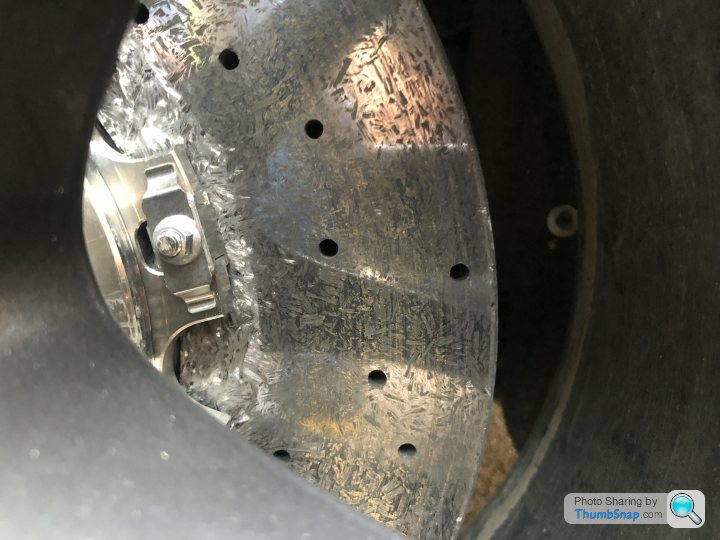Stradale brakes
Discussion
They look like they are well on their way. If these were in front of me I'd weight them and also check the caliper pistons.
Some info on how they wear: https://aldousvoice.com/2016/10/16/ferrari-maserat...
Some info on how they wear: https://aldousvoice.com/2016/10/16/ferrari-maserat...
Thanks for the responses.
The car is due for a service in the next 30 days, four year service which I understand is a major one, where I’ll request further checks such as weighing the discs.
The car is less than 2,000 miles on the clock and the interior is hardly worn so I’d be surprised if it’s clocked. Can you really destroy a set of discs in 2,000 miles?
Also can a granturismo owner tell me if this is normal:

Or is it a warning sign that it may have been in a shunt?
The car is due for a service in the next 30 days, four year service which I understand is a major one, where I’ll request further checks such as weighing the discs.
The car is less than 2,000 miles on the clock and the interior is hardly worn so I’d be surprised if it’s clocked. Can you really destroy a set of discs in 2,000 miles?
Also can a granturismo owner tell me if this is normal:

Or is it a warning sign that it may have been in a shunt?
CitySlicker said:
Thanks for the responses.
The car is due for a service in the next 30 days, four year service which I understand is a major one, where I’ll request further checks such as weighing the discs.
The car is less than 2,000 miles on the clock and the interior is hardly worn so I’d be surprised if it’s clocked. Can you really destroy a set of discs in 2,000 miles?
Also can a granturismo owner tell me if this is normal:

Or is it a warning sign that it may have been in a shunt?
I reckon that’s been tracked a LOT. Wouldn’t surprise me if most of the 2k miles was track days.The car is due for a service in the next 30 days, four year service which I understand is a major one, where I’ll request further checks such as weighing the discs.
The car is less than 2,000 miles on the clock and the interior is hardly worn so I’d be surprised if it’s clocked. Can you really destroy a set of discs in 2,000 miles?
Also can a granturismo owner tell me if this is normal:

Or is it a warning sign that it may have been in a shunt?
If that’s side sills I can check mine Sunday night when I’m home but my recollection is they aren’t as flush as you’d hope. Italian production!
Mattjevans said:
CitySlicker said:
Thanks for the responses.
The car is due for a service in the next 30 days, four year service which I understand is a major one, where I’ll request further checks such as weighing the discs.
The car is less than 2,000 miles on the clock and the interior is hardly worn so I’d be surprised if it’s clocked. Can you really destroy a set of discs in 2,000 miles?
Also can a granturismo owner tell me if this is normal:

Or is it a warning sign that it may have been in a shunt?
I reckon that’s been tracked a LOT. Wouldn’t surprise me if most of the 2k miles was track days.The car is due for a service in the next 30 days, four year service which I understand is a major one, where I’ll request further checks such as weighing the discs.
The car is less than 2,000 miles on the clock and the interior is hardly worn so I’d be surprised if it’s clocked. Can you really destroy a set of discs in 2,000 miles?
Also can a granturismo owner tell me if this is normal:

Or is it a warning sign that it may have been in a shunt?
If that’s side sills I can check mine Sunday night when I’m home but my recollection is they aren’t as flush as you’d hope. Italian production!
I took a photo of the tyre’s serial number so I’ll check whether they’re the original tyres or not.
Regarding the brakes the surface was smooth; it was mainly the corrosion on the outer edge which concerned me.
993rsr said:
Why, he’s incorrect.
You would be surprised how little needs to fall off the surface of the disc to put them under the min weight. The OP suggests that he is prior to purchase of the car so it makes absolute sense to get them weighed as part of the PPI. As soon as a chunk of material falls off the surface then that area can no longer provide a usable braking surface. The second picture in particular shows the dark patches not reflecting any light. To my eye this looks like the surface is worn.Whilst the discs are on the scale access to the pistons is good so again it makes sense to check them. There is no bellow type seal on these pistons and they frequently corrode which will see them seized in no time at all. At best a seized piston will reduce braking performance. At worst it'll hold the pad on the disc, causing excessive wear.
voicey said:
993rsr said:
Why, he’s incorrect.
You would be surprised how little needs to fall off the surface of the disc to put them under the min weight. The OP suggests that he is prior to purchase of the car so it makes absolute sense to get them weighed as part of the PPI. As soon as a chunk of material falls off the surface then that area can no longer provide a usable braking surface. The second picture in particular shows the dark patches not reflecting any light. To my eye this looks like the surface is worn.Whilst the discs are on the scale access to the pistons is good so again it makes sense to check them. There is no bellow type seal on these pistons and they frequently corrode which will see them seized in no time at all. At best a seized piston will reduce braking performance. At worst it'll hold the pad on the disc, causing excessive wear.
http://www.carbonceramicbrakes.com/en/technology/P...
Having owned PCCB equipped cars for 15 years, and as per the images below showing what constitutes carbon burn (from my 980 the dark areas on the periphery of the disc the friction surface is now gone) it's important to dismiss what with no doubt the best of intentions is duff information.

The rotor in the original posters image knowing the SGL product supplied for this car is fine and dandy.
993rsr said:
The friction surface does not 'fall off', it has to be exposed to extreme thermal shock which oxidizes the material, degrading the friction surface, which ultimately renders the rotor scrap. This is the case with the older variant of rotors, pre SGL Carbon incorporating an additional ceramic layer on the surface as featured (exclusively) on PAG cars.
http://www.carbonceramicbrakes.com/en/technology/P...
Having owned PCCB equipped cars for 15 years, and as per the images below showing what constitutes carbon burn (from my 980 the dark areas on the periphery of the disc the friction surface is now gone) it's important to dismiss what with no doubt the best of intentions is duff information.

The rotor in the original posters image knowing the SGL product supplied for this car is fine and dandy.
You muppet, do you have any idea of Voicey’s experience in this area...http://www.carbonceramicbrakes.com/en/technology/P...
Having owned PCCB equipped cars for 15 years, and as per the images below showing what constitutes carbon burn (from my 980 the dark areas on the periphery of the disc the friction surface is now gone) it's important to dismiss what with no doubt the best of intentions is duff information.

The rotor in the original posters image knowing the SGL product supplied for this car is fine and dandy.
Gassing Station | Maserati | Top of Page | What's New | My Stuff





